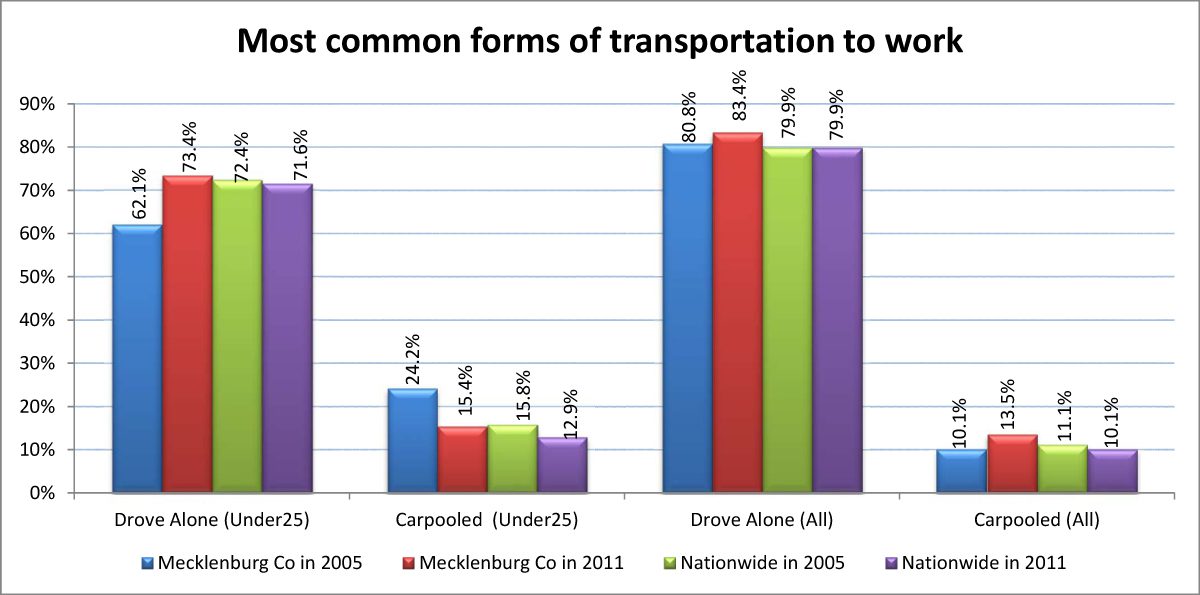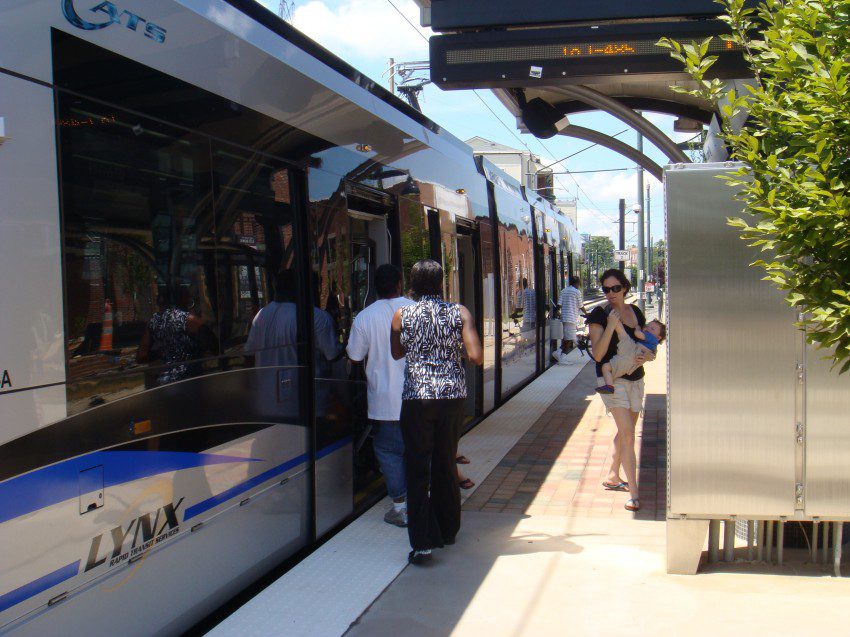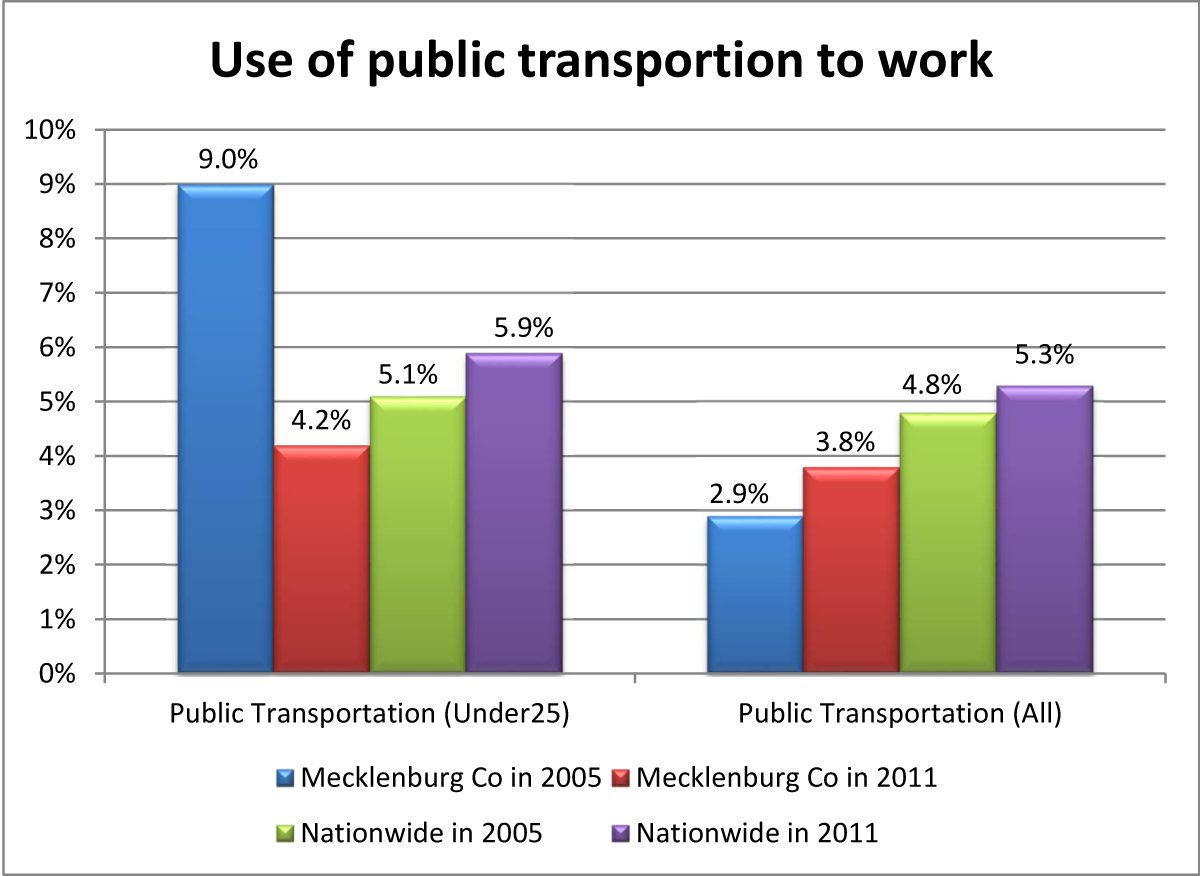Is Gen Y really breaking up with the car?

The Baby Boomer generation redefined the lifestyle, consumption patterns, and values of each new life stage they entered. Wherever Boomers flocked, prices rose and businesses changed in response to meet their needs. Will the GenY/Echo Boom/Millennial generation do the same? A flurry of articles citing new reports about Echo Boomers’ transportation preferences say, “Yes.” But don’t move so fast. The latest census data don’t show that to be the case in Mecklenburg County.
A major study released in April 2012 by the Frontier Group and US PIRG Education Fund, “Transportation and the New Generation,” revealed some surprising statistics. “By 2011, the average American was driving 6 percent fewer miles per year than in 2004,” it says. Further, Echo Boomers (so named due to a jump in birth rates between 1978 and 1994) are leading the way. “From 2001 to 2009, the average annual number of vehicle miles traveled by young people (16- to 34-year-olds) decreased from 10,300 miles to 7,900 miles per capita – a drop of 23 percent.”
Here are some other key findings of the Frontier report. How young people choose to get around is changing: in 2009 they took 24 percent more bike rides and walked to destinations 16 percent more frequently; in the decade of 2000, their use of public transit increased by 40 percent, and their share of those without a driver’s license increased from 21 to 26 percent.
What is causing this shift? Two main drivers are Echo Boomers’ desire to protect  the environment, and a rejection of their Baby Boomer parents’ sprawl-type, three-car garage, cul-de-sac lifestyle. “According to a recent study by the National Association for Realtors, young people are the generation most likely to prefer to live in an area characterized by nearby shopping, restaurants, schools, and public transportation,” says Frontier. This isn’t so surprising – young people often want a different life than the one their parents had. What is very different is how GenY’ers are “cruising.” Having your own wheels and loading up with friends has been replaced by many young people with “virtual cruising” via social networking, smart phones and online gaming.
the environment, and a rejection of their Baby Boomer parents’ sprawl-type, three-car garage, cul-de-sac lifestyle. “According to a recent study by the National Association for Realtors, young people are the generation most likely to prefer to live in an area characterized by nearby shopping, restaurants, schools, and public transportation,” says Frontier. This isn’t so surprising – young people often want a different life than the one their parents had. What is very different is how GenY’ers are “cruising.” Having your own wheels and loading up with friends has been replaced by many young people with “virtual cruising” via social networking, smart phones and online gaming.
But in the Charlotte area, those trends don’t appear to be happening. For instance, brothers, Vinny, 24, and Matthew Picco, 22, aren’t seeing a change in young people’s driving preferences. Both are students at UNC Charlotte and commute daily from their home in Unionville, about 28 miles away. They can’t ride together because their schedules are too different. “We both have our own cars. For us, it’s cheaper to commute and live at home than to have an apartment near campus,” said Vinny. “We shared a truck for a while after I turned 18, but I’ve had my own since I was 21. All my friends in high school had their own vehicles, too.”
External factors also have an effect. Changes in driving laws have many putting off getting a license. To help keep young drivers safe, every state now has Graduated Drivers’ Licensing (GDL) laws that raise driving ages, require more training and restrict driving with passengers. (These safety precautions may be especially important in the Charlotte metro area, ranked by Allstate insurance company as the ninth deadliest hotspot among the nation’s 50 largest metro areas for fatal teen crashes. )
)
Nationwide, high gas prices are keeping young people off the road. In 2001, it cost $1,100 on average to fill up for the year; today, that same tank costs $2,300 to fill. As the Frontier report says, “According to the U.S. Energy Information Administration’s projections, gas prices are expected to increase by 26 percent from 2010 to 2020.” In the throes of the current economic downturn there is less money for gas, so we are all driving less. And – especially appealing to digital natives who grew up plugged-in – online chatting, Skype and IM are free and don’t require driving at all.
According to Frontier, even young people who are employed and/or not experiencing financial distress are showing the same reduced driving habits. Those with jobs drove 10,700 miles in 2009, compared with 12,800 miles in 2001. From 2001 to 2009, young people who lived in households with annual incomes of more than $70,000 increased their use of public transit by 100 percent, biking by 122 percent, and walking by 37 percent.
This doesn’t seem to be trending in Mecklenburg County, though, according to the 2011 American Community Survey 1-year Estimates. Here, young people are driving more and using public transportation less. In 2005, 86.3 percent of those under age 25 drove alone or carpooled to work locally. In 2011, that increased to 88.8 percent. In the same time frame nationwide, 88.2 percent were driving or carpooling to work, but by 2011 the figure had dropped to 84.5 percent.
In a similar pattern, 9 percent of Mecklenburg’s under-25 population used public transportation to get to work in 2005. That fell to just 4.2 percent in 2011. Nationally, this group increased their use of public transportation slightly from 5.1 to 5.9 percent. Changes in younger drivers’ preferences don’t appear to be happening in Mecklenburg County.
Studies have consistently shown that reducing vehicle miles traveled (VMT) isn’t necessarily related to high residential density alone, but is at least partly due to reduced levels of auto ownership. Drivers in dense, urban areas use their cars as much as those in low-density areas.
What is different, though, is the option to live car-free. Those in urban areas own fewer vehicles per licensed driver, which helps lower VMTs per capita. A 2010 study published by professors Rachel Weinberger and Frank Goetzke in Urban Studies made the following, important conclusion. Preferences for car ownership (or not) are learned.  “Once the self-reinforcing ‘cultural knowledge’ of living without cars is lost, it could be difficult to regain,” they write. A focus on children and young adults is needed, to expose them to alternative transportation and fewer cars, in order to develop collective preferences for these ideas.
“Once the self-reinforcing ‘cultural knowledge’ of living without cars is lost, it could be difficult to regain,” they write. A focus on children and young adults is needed, to expose them to alternative transportation and fewer cars, in order to develop collective preferences for these ideas.
Don’t think car makers intend to take this trend lying down. They are responding to the buying habits of Millennials by adding technologies, safety features, and paint color options designed to appeal to them. Echo Boomers want to stay plugged in when they get in their cars, and safety features like lane-change and blind-spot warning systems, anti-lock brakes and emergency calling are all big favorites. Will these things be enough to entice Millennials to stay behind the wheel?
As with all long-term relationships, breaking up is hard to do. But what may be painful at the moment often turns out to be the best decision ever made. Government funding for transportation has historically been based on highway capacity and an assumption that Americans would drive more and more each year. However, our changing transportation preferences, especially those of young people, are cause for a “time out.” Will this be the tipping point that makes funding transit options a priority – or at least equal to that of roads? The break-up may be tough, but don’t worry – we can still be friends.